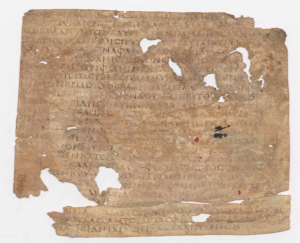Ambr. F 205 inf., Iliad text on the back of miniatures VI and VII: description
The reverse side of the double miniature contains twenty-five verses of the Iliad: 1.345–1.369. Reading these verses is difficult due to traces of the reagent used by Mai to detach the parchment from the paper, as well as other forms of material damage. Nevertheless, the calligraphic imprint of the writing can be discerned, characterised by a greater contrast between thick and thin strokes than in the 2nd-century AD model of the round capital letter, which had been obsolete for centuries. More generally, the writing is characterised by decorative stylistic elements that date to no earlier than the late 5th century (Cavallo 1973) and recalls two Homeric and Platonic papyrus fragments (P. Duke inv. G.5; P.Ant. II 78). The scholar attributes these fragments to the same copying centre in Alexandria as the Ilias Picta, on account of their exceptional nature. Here, the choice of a strongly archaic script would have been motivated by a desire to preserve ancient and pagan culture in the face of rampant Christianity.
As far as can be read, the text of this group of verses preserves part of the verses athetized by Aristarchus (366–392), from which it also differs in line 350 (ἐπ’ οἴνου : ἐπ’ ἀπείρων Ar.), while in line 351 it maintains his choice against Zenodotus (ὀρέγνης : ἀνέπτας Zen.). In all these cases, the text of the Ilias Picta coincides with the version best documented in the medieval tradition.


